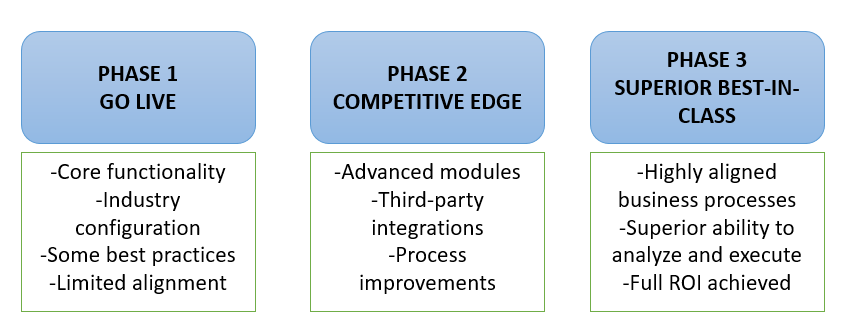When it comes to an ERP project, many business executives, even some CIOs, delegate their responsibilities for running an ERP project to the ERP solution implementer. They do this because this is an area they have little or no experience of, and no education about. What they need is an executive guide to ERP, and fortunately there is one. It’s a product-agnostic book called ‘Thinking About ERP’. This guide will help in the selection, implementation and ongoing operation of the ERP system.
Before starting an ERP project
As we pointed out elsewhere [What is ERP Part 1 blog], an ERP application automates, integrates and streamlines business processes. The reason executives want an ERP system is that they want to improve business processes in order to achieve certain organizational objectives. Using an ERP application is a more efficient and reliable way for an organization to manage business process data than relying on individuals, on point systems like Excel, or even worse, on paper.
A company has to have a compelling reason to get an ERP system. It’s a big-ticket item that needs levels of managerial and executive sign-off before being approved. Ultimately it is a board responsibility and ultimately they need to know the answer to the following questions:
What are you trying to achieve, why, and how?
In the words of Stephen Covey in ‘Seven Habits of Highly Effective People’, executives “should begin with the end in mind”, meaning begin the project with a clear vision of your desired direction and destination. Without doing so leads to a situation Lewis Carrol described (in Alice in Wonderland) as “If you don’t know where you are going, any road will take you there.”
Strategic objectives of an ERP project
The what and why of the question above is what are the strategic objectives that an ERP system will help accomplish. It’s likely that most of the ERP approval process will be taken up in addressing this question, as well as the cost, of course. In ‘Thinking About ERP’ it is recommended that the board appoint a senior executive as the ‘Seeker of Value’ whose role in the project is to determine the value to be gained from the ERP software. It may not be necessary for this person to quantify all the benefits but they must be clear. A formal document called ‘Case for Change’ should clarify the business benefits in a formal and unambiguous manner.
How an ERP system achieves objectives
The ‘Case for Change’ document specifies how and by when will the ERP project help achieve the objectives, and at what cost?
When it comes to objectives and benefits, executives shouldn’t try to cover everything but focus on some key items.
- Improved inventory: such as reduced volumes, faster turns, avoiding stock-outs.
- Complete and on-time shipment.
- Cost reductions: operational and administrative.
- Improved accounting: reduced days receivables, faster month-end closing.
- Improved procurement: better forecasting leading to better buying signals, and better discounts from suppliers.
- Improved manufacturing management: reduced re-work, fewer rush jobs, less overtime.
- Improved quality control: measured by reject rates, product returns, or customer complaints.
- Automation of manual processes: speed of execution before and after the project, reduction in staff resources needed.
Some objectives and benefits, however, will not be so quantifiable because it’s worth remembering the saying: “not everything important is measurable, and not everything measurable is important.” Some examples are:
- Apart from discounts, how do you measure better relationships with suppliers?
- How can improved customer service and loyalty be measured? This would be the result of better coordination between sales, procurement, manufacturing and warehouse functions.
For non-quantifiable benefits, categories or scales will be needed.
Where is the finish line?
Too often the end of an ERP project is determined by the go-live date, meaning the date the business starts using the ERP application for daily business transactions. Many organizations end up finishing early due to time, budget or resources issues and therefore miss out on more significant goals.

Justifying an ERP project
A major project will not gain much support if there are no obvious benefits. That is why the ‘Case for Change’ document is important because it identifies business objectives and benefits. As the project progresses it provides a reminder of why the project was undertaken. It also a tool that the Seeker of Value can use for retaining executive buy-in if problems occur. After go-live, the document is used to assess how the project delivered on the objectives and benefits expected.
Everyone wants the benefits of an ERP system in their business. Often though few people in the business itself have the experience and knowledge of how to make it happen. Thinking About ERP is the guide a business needs when starting an ERP project.
In Part 2, we will discuss the ‘how’ of the board’s question. A practical framework called the Degrees of Freedom.






